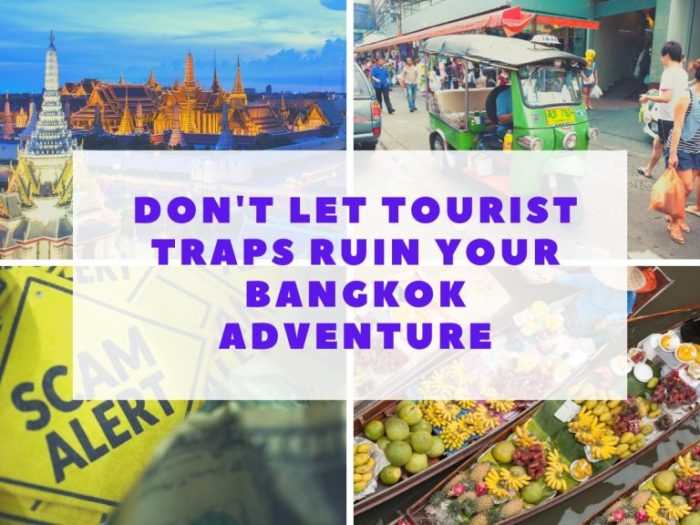
How to avoid expensive tourist traps on a shoestring budget is a question many budget-conscious travelers ask. This guide delves into practical strategies for experiencing the world without breaking the bank. We’ll explore affordable destinations, accommodation options, transportation choices, and budget-friendly dining, all while uncovering hidden gems and authentic cultural experiences that bypass the typical tourist traps. Discover how to maximize your travel experiences while minimizing your expenses, transforming your journey into an adventure filled with memorable moments instead of financial regret.
From researching affordable destinations and finding budget-friendly accommodations to navigating public transport and savoring authentic street food, this guide offers a comprehensive roadmap for savvy travelers. We’ll uncover hidden gems, share negotiation tips, and equip you with the knowledge to plan an unforgettable trip without sacrificing quality or exceeding your budget. Learn how to prioritize experiences over expensive tourist attractions, turning your shoestring budget into a passport to enriching adventures.
Researching Affordable Destinations

Choosing the right destination is crucial for a budget-friendly trip. Careful research can unlock incredible cultural experiences without breaking the bank. This section will guide you through identifying affordable yet culturally rich cities, comparing living costs, and understanding the pricing of popular tourist activities.
Budget-Friendly Cities with Rich Cultural Experiences
Five cities offering a compelling blend of cultural immersion and affordability include: Krakow, Poland; Budapest, Hungary; Seville, Spain; Porto, Portugal; and Medellín, Colombia. These cities boast historical architecture, vibrant local scenes, and delicious cuisine, all accessible without excessive spending. Each offers unique cultural attractions and experiences, ensuring a diverse range of options for the budget traveler.
Cost of Living Comparison: Three Urban Areas
Comparing the cost of living across different cities provides a clearer picture of potential budget requirements. Let’s consider Krakow, Poland; Seville, Spain; and Medellín, Colombia. Accommodation in Krakow can range from budget-friendly hostels (around €15-€25 per night) to more comfortable Airbnb options (€40-€80). Seville tends to be slightly more expensive, with hostels starting around €20-€30 and Airbnbs from €50-€100.
Medellín offers a wider range, from very affordable hostels (€10-€20) to mid-range Airbnbs (€30-€70). Food costs vary considerably depending on dining choices. Street food and local markets in all three cities offer extremely affordable options (around €5-€15 per day), while restaurant meals can range from €15-€40 per person. Transportation is generally inexpensive in all three cities, with extensive public transport networks.
Daily travel costs could be as low as €5-€10 using buses and trams.
Average Prices of Popular Tourist Activities
The following table compares the average prices of popular tourist activities across five cities: Krakow, Budapest, Seville, Porto, and Medellín. Prices are approximate and can fluctuate depending on the season and specific activity.
| City | Museum Entry (per person) | Walking Tour (per person) | Food Tour (per person) | Day Trip (per person) |
|---|---|---|---|---|
| Krakow | €10-€15 | €15-€25 | €30-€45 | €40-€60 |
| Budapest | €8-€12 | €12-€20 | €25-€40 | €35-€55 |
| Seville | €12-€18 | €18-€30 | €35-€50 | €50-€75 |
| Porto | €10-€15 | €15-€25 | €30-€45 | €45-€65 |
| Medellín | €5-€10 | €10-€20 | €20-€35 | €30-€50 |
Finding Affordable Accommodation: How To Avoid Expensive Tourist Traps On A Shoestring Budget
Securing affordable lodging is crucial for budget travelers. The good news is that numerous alternatives exist beyond the typical, often expensive, hotel. Smart choices in accommodation can significantly impact your overall trip cost, allowing you to allocate more funds towards experiences and activities.
Alternative Accommodation Options
Budget travelers have a wealth of options available, offering varying levels of comfort and privacy. Hostels provide budget-friendly dorm rooms or private rooms, ideal for solo travelers or those comfortable with shared spaces. Guesthouses often offer a more personal experience with locally-owned properties and potentially home-cooked meals. Airbnb provides access to a wide range of privately-owned apartments, houses, or rooms, offering greater independence and potentially more space than a hotel room.
Finally, homestays offer an immersive cultural experience by allowing you to stay with a local family, gaining valuable insights into the local culture and lifestyle. For example, a hostel like Generator in London offers stylish dorm rooms and private rooms at competitive prices. A guesthouse such as the charming Casa Luna in San Miguel de Allende, Mexico, provides a cozy and authentic experience.
Airbnb offers diverse options; you might find a cozy studio apartment in Paris or a spacious villa in Bali, depending on your needs and budget. A homestay in rural Japan could offer a truly unique cultural immersion, including opportunities to participate in local traditions.
Negotiating Lower Accommodation Prices
Several strategies can help secure lower prices on accommodation. Booking in advance, especially during off-peak seasons, often yields better deals. Websites like Booking.com and Expedia allow for price comparisons across different platforms. Flexibility with your travel dates can also result in significant savings, as prices fluctuate based on demand. Consider contacting the accommodation provider directly; sometimes, you can negotiate a lower rate, particularly if you are staying for an extended period.
Finally, look for special offers or discounts; many accommodations offer promotions for longer stays or bookings made through specific channels. For example, booking a week-long stay might unlock a significant discount compared to booking individual nights.
Example Budget Travel Itinerary: A Week in Southeast Asia
This itinerary demonstrates how choosing affordable accommodation can dramatically impact a week-long trip’s budget. The example focuses on a hypothetical trip to Southeast Asia, known for its affordability.
| Day | Location | Accommodation | Cost (USD) |
|---|---|---|---|
| 1-3 | Bangkok, Thailand | Hostel Dorm Room | $21 (7 days) |
| 4-5 | Chiang Mai, Thailand | Airbnb Private Room | $35 (2 days) |
| 6-7 | Luang Prabang, Laos | Guesthouse | $42 (2 days) |
Note: This itinerary excludes flights and other expenses. Costs are estimates and can vary based on season and availability.
Budget-Friendly Transportation
Navigating a new city without breaking the bank requires a strategic approach to transportation. Choosing the right mode of transport can significantly impact your travel budget and overall experience. This section explores various budget-friendly transportation options, comparing their costs and convenience to help you make informed decisions.Public transportation systems offer a cost-effective and often efficient way to explore cities worldwide.
From bustling metropolises to smaller urban centers, well-developed public transit networks can save you considerable money compared to taxis or ride-sharing services. Understanding the nuances of each system, however, is crucial for maximizing its benefits.
Public Transportation System Usage
Utilizing public transportation effectively involves several key steps. First, research the city’s transit system before your arrival. Many cities have user-friendly websites and mobile apps that provide maps, schedules, and real-time updates. Familiarizing yourself with the routes and fares will prevent confusion and delays once you’re on the ground. Secondly, purchase tickets or passes in advance whenever possible.
Many systems offer discounts for multi-day or multi-ride passes, which can save you a substantial amount of money compared to paying per ride. Finally, be mindful of peak hours. Traveling during off-peak times generally results in a more comfortable and less crowded journey. For example, in London, purchasing an Oyster card or using contactless payment on the Tube (subway) is far more economical than using individual tickets, and avoiding rush hour (7:00 AM – 9:00 AM and 5:00 PM – 7:00 PM) can significantly reduce travel time.
In New York City, a 7-day unlimited MetroCard provides unlimited subway and bus rides, making it a very cost-effective option for longer stays.
Transportation Method Comparison
Different transportation methods present varying cost and convenience trade-offs. Buses are typically the cheapest option, offering extensive coverage across a city, but can be slower due to traffic and frequent stops. Trains, while often more expensive than buses, provide faster and more comfortable travel, particularly for longer distances. Subways offer a rapid transit option, typically efficient and cost-effective for navigating urban centers, but their coverage may be limited to specific areas.
Ride-sharing services, such as Uber and Lyft, offer door-to-door convenience but are generally the most expensive option, particularly during peak hours or in areas with high demand. For instance, a bus ride in Bangkok might cost a few baht, while a taxi or Grab (a ride-hailing app popular in Southeast Asia) for the same distance could cost significantly more.
Similarly, a subway ride in Paris is considerably cheaper than a taxi journey of comparable distance.
Step-by-Step Guide to Using Public Transportation in a Major City
Let’s consider a hypothetical example using the public transportation system of a major European city like Paris. First, you would research the RATP (Régie Autonome des Transports Parisiens) website or app to plan your routes. Next, you might purchase a Navigo Découverte pass (a weekly pass) if your stay is longer than a few days, or individual tickets (tickets t+) for shorter trips.
Then, you would locate the nearest metro station using the RATP map or app. Upon reaching the station, you would validate your ticket at the entrance gate. Finally, you would follow the signage and announcements to navigate the metro system and reach your desired destination. Remember to always check the destination displayed on the train to ensure you’re boarding the correct one.
This systematic approach can be adapted to most major cities worldwide, requiring only a slight modification to account for local variations in the transit system and ticketing procedures.
Eating on a Shoestring Budget
Eating affordably while traveling doesn’t mean sacrificing delicious food. With a little planning and resourcefulness, you can enjoy diverse and satisfying meals without breaking the bank. This section explores strategies for minimizing food costs and maximizing culinary experiences on a budget trip.
Five Affordable Food Options in a Typical City
Finding cheap and cheerful meals is surprisingly easy in most cities. Focusing on local options and avoiding tourist-centric restaurants is key. Here are five common and affordable choices:
- Local Markets and Supermarkets: Purchasing groceries from local markets or supermarkets allows for significant cost savings compared to eating out at restaurants. Prepare simple meals in your accommodation (if facilities allow) or enjoy picnics in parks.
- Street Food Stalls: Street food offers an authentic and inexpensive taste of local cuisine. From tacos in Mexico to Pad Thai in Thailand, street vendors often offer the best value for money.
- Cafeterias and Local Eateries: These establishments, often frequented by locals, typically offer set menus or daily specials at significantly lower prices than tourist restaurants. Look for places that are busy with locals – it’s a good indicator of quality and value.
- Food Courts in Shopping Malls: Many shopping malls feature food courts offering a wide variety of cuisines at reasonable prices. This can be a convenient option, especially during inclement weather.
- Ethnic Enclaves: Explore ethnic neighborhoods, often known for their authentic and budget-friendly restaurants. These areas frequently have smaller, family-run businesses offering delicious meals at significantly lower prices than tourist traps.
Weekly Meal Plan for a Budget Traveler
This sample meal plan demonstrates how to eat well on a limited budget, assuming a daily food budget of $15. Prices are estimates and will vary depending on location.
| Day | Meal | Description | Estimated Cost | Location |
|---|---|---|---|---|
| Monday | Breakfast | Oatmeal with fruit | $2 | Supermarket |
| Lunch | Sandwich from a local bakery | $4 | Local Bakery | |
| Dinner | Pasta with tomato sauce (made with supermarket ingredients) | $5 | Accommodation | |
| Tuesday | Breakfast | Yogurt and granola | $3 | Supermarket |
| Lunch | Leftover pasta | $0 | Accommodation | |
| Dinner | Street tacos (3 tacos) | $6 | Street Food Stall | |
| Wednesday | Breakfast | Banana and coffee | $2 | Supermarket/Cafe |
| Lunch | Salad from a cafeteria | $5 | Cafeteria | |
| Dinner | Soup and bread from a local eatery | $6 | Local Eatery | |
| Thursday | Breakfast | Toast with jam | $2 | Accommodation |
| Lunch | Leftover soup and bread | $0 | Accommodation | |
| Dinner | Chicken and rice from a food court | $7 | Food Court | |
| Friday | Breakfast | Scrambled eggs | $3 | Accommodation |
| Lunch | Leftover chicken and rice | $0 | Accommodation | |
| Dinner | Pizza slice from a local pizzeria | $5 | Local Pizzeria | |
| Saturday | Breakfast | Pastries from a local bakery | $4 | Local Bakery |
| Lunch | Picnic from supermarket | $5 | Park | |
| Dinner | Ethnic restaurant meal (shared with a friend) | $8 | Ethnic Enclave | |
| Sunday | Breakfast | Pancakes (made with supermarket ingredients) | $4 | Accommodation |
| Lunch | Leftover ethnic food | $0 | Accommodation | |
| Dinner | Simple home-cooked meal (supermarket ingredients) | $6 | Accommodation |
Tips for Finding Affordable and Authentic Street Food Experiences
Street food offers a fantastic opportunity to experience local culture and cuisine at a fraction of the cost of restaurants. However, some precautions are necessary.
- Look for busy stalls: High turnover generally indicates fresh food and good quality.
- Observe hygiene practices: Choose stalls that appear clean and handle food hygienically. Avoid stalls with unrefrigerated perishable items.
- Try a variety of options: Don’t be afraid to experiment and sample different dishes. Many street food vendors offer small portions at low prices, allowing you to try multiple items.
- Ask locals for recommendations: Locals often know the best and most affordable street food spots.
- Carry small bills and coins: This avoids delays and potential issues with change.
- Be mindful of your surroundings: Pay attention to your belongings and surroundings, especially in crowded areas.
Free and Low-Cost Activities

Exploring the world on a shoestring budget doesn’t mean sacrificing enriching experiences. Many cities offer a wealth of free and low-cost activities that can make your trip memorable without breaking the bank. By prioritizing free attractions and opting for budget-friendly alternatives, you can maximize your travel experience while minimizing expenses. This section will highlight free and low-cost activities in several major cities and provide a sample itinerary.
Many cities boast a fascinating array of free and affordable attractions, often overlooked by those focused solely on paid experiences. These activities provide opportunities for cultural immersion, exploration, and relaxation, all without significant financial investment. Smart planning and a little research can reveal hidden gems that enrich your travel experience significantly.
Free and Low-Cost Activities in Major Cities, How to avoid expensive tourist traps on a shoestring budget
The following list provides examples of free and low-cost activities available in five major cities. These are just starting points; further exploration will reveal many more.
- London, England: Walking tours of historical neighborhoods, visiting free museums (British Museum, National Gallery), exploring Hyde Park or Regent’s Park, attending free events in Trafalgar Square.
- New York City, USA: Walking the Brooklyn Bridge, exploring Central Park, visiting free museums (Metropolitan Museum of Art – pay-what-you-wish admission), strolling through Greenwich Village, attending free concerts in various parks.
- Paris, France: Walking along the Seine River, visiting free parks and gardens (Luxembourg Gardens, Tuileries Garden), exploring Montmartre, window shopping along the Champs-Élysées, attending free outdoor markets.
- Rome, Italy: Visiting free churches and basilicas (St. Peter’s Basilica, Pantheon), exploring the Colosseum and Roman Forum (consider purchasing a combined ticket for access to other sites), walking through Trastevere, enjoying the atmosphere of Piazza Navona.
- Tokyo, Japan: Exploring free temples and shrines (Senso-ji Temple, Meiji Jingu Shrine), wandering through Ueno Park, strolling through Shibuya Crossing, enjoying the vibrant atmosphere of Shinjuku Gyoen National Garden (small entrance fee).
Three-Day Itinerary: Free and Low-Cost Activities in London
This itinerary focuses on maximizing London’s free and affordable offerings.
- Day 1: Explore the South Bank, including the Tate Modern (free entry), walk across the Millennium Bridge, and visit Borough Market (food stalls offer varied price points).
- Day 2: Visit the British Museum (free entry), wander through Hyde Park, and enjoy a picnic lunch. In the evening, explore a neighborhood like Notting Hill.
- Day 3: Walk through St. James’s Park, visit Buckingham Palace (free viewing from outside), and explore Westminster Abbey (entrance fee applies, but exterior is free to view).
Experiencing the British Museum
A visit to the British Museum provides a profound experience of world history and culture, all without an entrance fee. The sheer scale of the collection is overwhelming, encompassing artifacts from across millennia and continents. The atmosphere is one of hushed reverence, punctuated by the murmurs of visitors and the occasional guided tour. The sheer diversity of the artifacts – from the Rosetta Stone to ancient Egyptian mummies – allows for hours of exploration, focusing on areas of personal interest.
The museum’s layout is intuitive, and informative plaques accompany most exhibits, enhancing the learning experience. The overall experience is one of intellectual stimulation and cultural immersion, a testament to the power of free access to significant historical treasures.
Avoiding Tourist Traps
Navigating popular tourist destinations on a budget requires a keen eye for value and a willingness to stray from the well-trodden path. Tourist traps, while often visually appealing, typically inflate prices and offer a diluted, inauthentic experience. By understanding common tactics and seeking out alternatives, budget travelers can significantly enhance their trip while saving money.Many popular tourist destinations employ strategies designed to maximize profits from unsuspecting visitors.
These tactics range from inflated prices for goods and services to misleading advertising and the creation of artificial demand. Understanding these mechanisms is the first step in avoiding them.
Common Tourist Traps and Avoidance Strategies
Tourist traps often present themselves as convenient or must-see attractions, but closer inspection reveals overpriced experiences and underwhelming quality. For example, in many major cities, horse-drawn carriage rides near iconic landmarks are significantly more expensive than utilizing public transport or simply walking. Similarly, restaurants located directly on popular tourist routes often charge inflated prices for mediocre food, while less conspicuous establishments nearby offer similar meals at considerably lower costs.
To avoid these pitfalls, it’s advisable to research alternatives beforehand, read online reviews carefully, and venture slightly off the main tourist thoroughfares. Comparing prices and reading reviews from various sources can provide a clearer picture of what to expect.
Comparing Tourist Attractions with Local Alternatives
A comparison between tourist-oriented attractions and their local counterparts often reveals a stark difference in price and authenticity. For instance, a guided tour of a famous museum might cost upwards of $50, while independent exploration, aided by a well-researched itinerary and perhaps an audio guide downloaded in advance, could cost a fraction of the price. Similarly, a traditional cooking class offered to tourists may cost $100 or more, while a local market visit and a quick chat with a friendly vendor might offer a far more genuine and affordable culinary experience.
The key is to actively seek out the local experiences rather than relying on pre-packaged tourist options.
Finding Authentic Local Experiences
Discovering authentic local experiences requires a proactive approach. Instead of relying on pre-arranged tours, consider exploring local markets, attending community events, or engaging with locals through casual conversation. This might involve visiting smaller, family-run restaurants, attending local festivals, or taking a cooking class with a local family instead of a large tourist-oriented organization. Learning a few basic phrases in the local language can significantly enhance interactions and open up opportunities for more authentic encounters.
Exploring neighborhoods beyond the immediate tourist zones often reveals hidden gems and offers a glimpse into the everyday life of the city’s residents. By immersing yourself in the local culture, you can create unforgettable memories that are both enriching and affordable.
Ultimately, avoiding expensive tourist traps on a shoestring budget is achievable with careful planning and a willingness to embrace local experiences. By researching affordable destinations, opting for alternative accommodations, utilizing public transportation, and seeking out authentic food options, you can create a memorable and enriching travel experience without depleting your savings. Remember, the most rewarding journeys often involve stepping off the beaten path and discovering the hidden treasures that lie beyond the typical tourist hotspots.
Embrace the adventure, and let your resourcefulness unlock a world of possibilities.
Query Resolution
What if I can’t find affordable accommodation in my desired city?
Consider extending your search radius to nearby towns or cities with cheaper options. Alternatively, adjust your travel dates to avoid peak season, or be flexible with your accommodation type (e.g., consider hostels or camping).
How can I ensure food safety when eating street food?
Choose vendors with high turnover (indicating fresh food), look for busy stalls, and avoid anything that looks undercooked or questionable. Opt for foods that are cooked thoroughly and served hot.
What should I do if I encounter a scam while traveling?
Remain calm, do not engage further with the scammer, and report the incident to local authorities or your embassy/consulate if necessary. Be cautious and avoid sharing personal information readily.
Are travel insurance essential for budget travelers?
While it might seem like an added expense, travel insurance is highly recommended, as it can protect you against unexpected medical emergencies, lost luggage, or trip cancellations, saving you significant costs in the long run.




